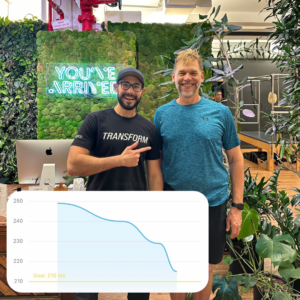Ensuring proper technique when working out is paramount, especially in a hybrid training environment. When working out with a personal trainer, both in-person and virtually, regardless of the type or intensity of the exercise, it can be challenging to try new workouts and maintain proper form.
What is a Hybrid Training Program?
Hybrid training is a blended training model incorporating in-person and online workouts with a personal trainer. This blended approach combines the benefits of both training methods to create a more flexible and comprehensive training experience for clients. In-person training is the traditional method where participants and trainers meet in a physical location, such as a gym, office, classroom, or training center. This form of training is beneficial as it offers hands-on demonstrations, instant feedback, and social interaction.
Virtual training, on the other hand, involves personal training sessions conducted over platforms such as Zoom, Webex, or specialized training software. Clients can join from anywhere as long as they have internet. Online personal training offers convenience and flexibility for busy schedules, easy accessibility, and the option to rewatch recorded sessions. Virtual training and at-home workouts gained popularity during the COVID-19 pandemic when people were confined to their homes and gyms were closed down. Some people found that they enjoyed virtual workouts better than in-person, whereas some reported that they preferred a combination.
The Benefits of a Hybrid Training Model
The hybrid training model has proven effective for clients and personal trainers. Clients have the flexibility to choose the mode of training that best fits their schedule, learning preferences, or current circumstances. Personal trainers or organizations can reach clients who cannot attend in-person sessions due to distance, health, or other personal reasons. Hybrid training also reduces the need for travel or physical infrastructure, saving costs for trainers and clients. This training method allows clients to move at their own pace, especially with asynchronous virtual components. The combination of in-person and virtual sessions will enable trainers to use various tools, from hands-on demonstrations to digital simulations or interactive quizzes. It provides an alternative for individuals who feel more comfortable working out from the comfort of their own rather than in front of others.
The mix of in-person and online personal training helps eliminate issues with achieving proper form and technique with specific exercises. Good form when working out is essential, as improper technique can limit progress while posing the risk of injury.
The Importance of Proper Technique When Working Out
Proper form and technique when exercising are vitally crucial for various reasons. Emphasizing correct form when working out not only maximizes the benefits of each exercise but also minimizes the risk of injuries. Improper form when working out can strain muscles and stress joints, leading to acute and chronic injuries. By ensuring proper technique, you reduce the risk of these complications. Having the correct form confirms that you’re targeting the intended muscles and getting the most out of each rep. For example, squatting with improper form might not effectively target the glutes and quads, making the exercise less effective.
You can ensure consistent and measurable progress in your fitness journey with proper exercise techniques. Without it, you might hit plateaus from ineffectively challenging the intended muscle groups. Incorrect form can lead to imbalances when overworking some muscles while underworking others. Proper technique ensures balanced muscle development when working out. Correct form often aligns with the body’s natural biomechanics, ensuring joints move properly and muscles function optimally. Regularly exercising with proper form can lead to better posture, whereas improper form can reinforce lousy posture. Avoiding injuries and consistently making progress will encourage you to stick with your workout routine in the long term. Proper form establishes a solid skill set for more complex exercises or heavier weights as you progress on your fitness journey. Executing your workouts correctly boosts your confidence in the gym, motivating you to try new exercises and push yourself further.
Ensuring Safety and Proper Technique in a Hybrid Workout Program
In a hybrid training program, personal trainers and clients face the challenge of establishing proper techniques across different training environments. At AP Transform Fitness, we prioritize ensuring you’re achieving proper form with your custom workout plan. Our personalized training programs are designed to provide our clients with the most effective methods for their fitness journey. We believe continuous fitness education is essential in both in-person and online settings. Clients should be informed about the importance of proper form, not just for the efficacy of the exercise but, more importantly, for their safety. The safety of our clients is first and foremost, which is why we prioritize demonstrating our workouts straight-forward and in detail for our clients to comprehend clearly.
We ensure that our clients understand the potential risks of improper technique so that they can be proactive in seeking feedback and self-correcting. Our hybrid training environments include regular check-ins to review techniques. Some sessions may focus solely on improving your technique rather than introducing new exercises or intensifying workouts. While hybrid training offers numerous advantages, clients’ safety depends on upholding proper technique in their workout program, both in-person and virtually. With intentional strategies and commitment to our clients, AP Transform Fitness ensures clients will receive the benefits of their workout program without compromising health or safety.
1. Leveraging the Strengths of Each Format
In-person workout sessions will be utilized for hands-on adjustments, comprehensive form checks, and teaching complex movements. Virtual sessions can be used for follow-up sessions, routine checks, and reviewing recorded sessions to find areas needing improvement.
2. Giving Clear Demonstrations
Clear, detailed demonstrations of each exercise will be provided for in-person and online sessions. Virtual sessions can also be recorded to refer back to any time for instructions.
3. Providing Consistent Feedback
For in-person training sessions, clients will receive consistent, real-time feedback during their workouts. During virtual sessions, exercises can be performed from different angles to provide a comprehensive view and form check. If clients are unsure of their form, we might encourage them to record themselves doing the exercises to give proper feedback.
4. Effectively Communicating
Communication is vital for the client and the trainer, so we use clear and consistent cues and terminologies in person and virtually. Our goal at AP Transform is to foster an open line of communication so our clients feel comfortable voicing any concerns and questions.
5. Emphasizing Self-Awareness
Since we cannot spot you during virtual sessions, we will avoid high-risk exercises and heavy weights depending on your environment and progress. It’s important to recognize what correct form feels like to ensure you’re performing exercises correctly. If something feels off or uncomfortable, you should communicate with your trainer immediately.
6. Using Mirrors for Visual Feedback
In in-person and virtual sessions, having a full-body mirror helps clients see and fix their form in real-time. While it is not required, exercising in front of a mirror can help ensure proper technique and boost confidence when working out.
7. Providing Written or Visual Resources
When necessary, we will offer handouts, infographics, or tutorial video links that restate key points about technique and form for exercises in the workout program.
At AP Transform Fitness, our hybrid training programs allow clients to reap the benefits of combining in-person and virtual workouts. If you’re ready to begin your fitness journey, contact us today, and we’ll get you started!
References:
-
ACSM’s Health & Fitness Journal, 2021. Worldwide Survey of Fitness Trends for 2021.
-
Psychology Today, 2019. Should You Exercise in Front of a Mirror?


